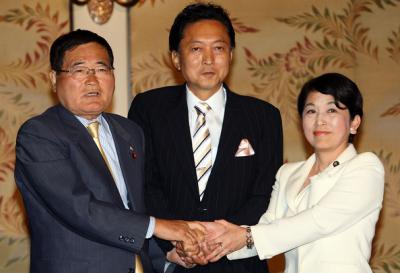The DPJ still holds a slim majority in the upper house with the PNP – perhaps thanks to the work of the ‘devil’ — and will undoubtedly press harder to get its legislation passed without having to extend the current Diet session.
Jun Okumura questions whether electoral cooperation is the wisest decision for its survival ‘as an anti-business, anti-Japan-US alliance protest party.’ In this statement, of course, one sees the problem with the coalition between the DPJ and the SDPJ. With 308 seats – including 221 of 300 single-member districts – in the House of Representatives, electoral dynamics suggest that the DPJ would drift to the centre once in power, as it needs to maintain pluralities in as many districts as possible.In this sense, perhaps the only surprising thing about the Hatoyama government’s embrace of the old agreement is that it tried so hard and so long to find an alternative to accommodation.
Some might say that the DPJ is becoming the old LDP, although I don’t think that’s a particularly meaningful assessment: Futenma, and Ozawa’s courtship of old LDP interest groups notwithstanding, the DPJ’s priorities and identity remain distinct. If the LDP and the DPJ increasingly resemble each other (and if the LDP survives), it is because survival in a political system dominated by non-aligned voters will produces moves to the centre in order to satisfy as many floating voters as possible, combined with rhetorical and symbolical gestures to distinguish one from the other.
The SDPJ is in wholly different circumstances. The party has only seven seats in the lower house, four from proportional blocs and three from single-member districts. One of those three — Teruya Kantoku — is from Okinawa’s second district. As a marginal party, the SDPJ’s survival depends on offering something unique to a narrow slice of core supporters, in this case left-wing ideologues who share its commitment to reducing the US presence in Japan, resisting revision of the constitution, and resisting growing inequality.
While on paper there appears to be some basis for cooperation between the SDPJ and the DPJ, the reality is that for the DPJ compromise is indispensable (for large parties, manifestos, one might say, are made to be broken), while for the SDPJ its survival depends on rigid adherence to its principles and promises. Had the LDP not fallen into such disarray, the coalition might have survived a bit longer in mutual resistance to a convenient enemy, but the electoral dynamics of the coalition seem to have doomed the partnership in advance.
Electoral dynamics were compounded by the SDPJ’s history. The old Socialist Party virtually broke itself by compromising its principles on the security alliance and the SDF to form a coalition with the LDP in 1994. That choice may have been the result of the party’s failure to recognise that the JSP was becoming a marginal ideological party even before electoral reform: in 1993, the party actually lost 66 seats, most of them to the LDP splinter parties that would form the non-LDP coalition after the election. In other words, having betrayed its core supporters on the alliance once before, it was extremely unlikely that Fukushima would act differently than she did.
In short, Fukushima had to reject the prime minister’s compromise on account of the past, present, and future of the SDPJ. The party’s future is still precarious – it is not immediately clear which party gains more from electoral cooperation without cooperation in government – but having stood on principle, the SDPJ should have an easier time maintaining its electoral base.

